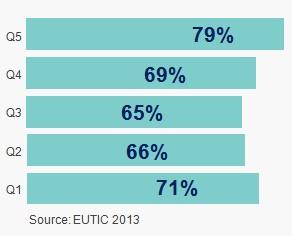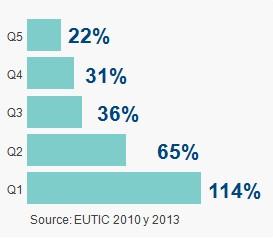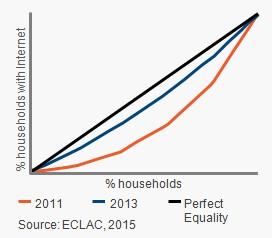1. Introduction
Uruguay is a country with well-aligned priorities which are firmly grounded on equity and quality of life. Despite being similar to developed countries from a socio-demographic perspective, Uruguayan economy is rather smaller within the same global and highly competitive system. Under these circumstances, in order to improve the welfare of the population and to boost the economic growth, it was essential to have a smart use of technology, enhancing the quality of education, government services and productive development, among others.
That is why Uruguay has been carrying out a comprehensive and continuous digital policy over several administrations, with a strong institutional structure responsible for its promotion. The Digital Agenda for Uruguay is not a government plan; it is a commitment of the country, a multi-stakeholder agreement between representatives of government, the academia, the private sector and the technical community. All stakeholders are involved in its orientation, implementation and monitoring, through a National Council for the Information Society. The most relevant aspect is that the agreements are not limited to a national technology plan: They focus on social inclusion, to provide better opportunities especially to the most excluded ones, and on strengthening national capacities through ICTs.
2. The Institutionalism
2.1 The Agency for e-Government and Information Society (AGESIC)
AGESIC is a presidential agency officially established in December 2005 and entered operation by the end of 2006 and early 2007. It has the role both of articulating the country’s digital policy, as of leading the e-Government strategies. Likewise, and under the premise of promoting higher confidence levels when using ICT, diverse aspects converge in its scope, such as information security, electronic certification, data protection and Internet governance; all this under a holistic view that has become its strongest differential.
The Agency is led by a Board of Directors comprising representatives from the government, the academia, the private sector and the technical community, all of them appointed by the President. It has five advisory councils on Information Society, Public Sector, Business, Geo-referenced Systems and Information Security. Three regulatory units with technical autonomy are subordinate to the Agency related to: Transparency, Privacy, and e-Certification. With regards to the e-Government, it has five main departments: Digital Citizenship, Agencies and Processes, Technology, Operations and Information Security, with the Computer emergency response team (CERTuy) which reports to the latter. With respect to the digital policy, the Agency has a Department for Information Society which has the responsibility of articulating, monitoring and promoting the commitments of the digital agenda.
2.2. National Council for Information Society
Established in 2006, the National Council for Information Society advises the Agency on the design, monitoring and evaluation of the digital policy. It is composed by different stakeholders with responsibilities over the objectives and targets of the digital agenda. The Council meets twice a year to make decisions regarding the implementation of the policy.
3. Digital Agenda for Uruguay

From the year 2007 and over several administrations, Uruguay has achieved consensus on the country’s digital policy with a continuous, systematic and evolutionary work reflected in the Placeholder for Copyright information.
three editions of the Digital Agenda for Uruguay issued to date (2007-2008, 2008-2010 and 2011-2015).
The Digital Agenda for Uruguay is a dynamic roadmap where different concepts are combined with government objectives related to development, in the context of the Information and Knowledge Society. The policy establishes the unanimous commitment of all stakeholders, in order to provide the means to accomplish all the outlined goals. While previous versions focused primarily on setting up the necessary infrastructure to achieve further goals, the third edition focuses on offering direct and tangible benefits to the citizens.
The policy for 2011-2015 comprised seven strategic lines that emerged from priorities set out by the Government; six action areas, common fields in which related objectives are grouped together; fifteen objectives associated to a set of projects; and fifty nine specific and measurable targets, allowing to assess their completion level. The Digital Agenda for Uruguay is therefore more than a political statement; its more distinguishing feature is that it establishes verifiable goals.
Strategic lines and areas 2011-2015
Seven strategic guidelines are the foundation of the digital agenda. Each one of the objectives and targets are not only touched and inspired by these guidelines but they also contribute to their compliance.
Table 1. Strategic lines of the digital agenda
| Equity and social inclusion | creating more and better opportunities, especially for the most excluded ones |
| Civil participation | listening to the citizen’s voice, fostering transparency and open data |
| State transformation | improving the quality of services provided to people |
| Foster education | training, favoring the production of contents, and quality assessment |
| Innovation and knowledge | boosting the use of ICTs to produce added value |
| Territorial integration | mitigating territorial gaps, the concentration of resources and government services |
| International insertion | fostering agreements on policies and the regulatory frameworks needed |
The digital policy focuses on five specific areas:
- ACCESS: “Connectivity for inclusion”
- EDUCATION AND CULTURE: “Building capabilities for the future”
- ELECTRONIC GOVERNMENT: “A modern public administration serving the citizens”
- PRODUCTIVE DEVELOPMENT: “Adding value to the domestic productive chain”
- HEALTH: “ICT for improving healthcare quality”
- ENVIRONMENT: “Responsible use of ICT”
E-Government is a key component of the digital policy. This action area contains 18 of the 59 targets that are related to the modernization of public sector management, electronic access to public administration as a right, a whole-of-government, and an efficient and reliable public administration in the use of ICT.
4. Flagships Initiatives
Uruguay is internationally-renowned for a range of projects which have earned various worldwide prizes in recent years, boosted by the digital policy. One of the most recent and most significant award was the «ICTs in Sustainable Development Award» granted at the opening of the 70th Session of the UN General Assembly in September 2015. The main flagship initiatives are described below.
4.1 CEIBAL plan
CEIBAL Plan placed Uruguay as the first country to provide all students and teachers in the public education system their own free personal computer. CEIBAL has been much more than delivering PCs: From the very design of this social inclusion program, the government was convinced that access was necessary but not sufficient to achieve the desired impact of ICT on the quality of life. Therefore, the right to have access to computers was accompanied by the right to have access to the Internet, with the strong commitment that no child should walk more than 300 meters from their homes to access the Internet. This has had a redistributive effect by ensuring that most Uruguayans have access to these tools, in many cases for the first time. As connectivity is not sufficient either, it was complemented by working with parents and teachers, communities for content development and developing strategies to reduce truancy. Likewise, educational management systems and online and real-time student assessment systems were introduced, to point some concrete efforts.
4.2. Infrastructure
The leading telecommunications company in the country is state owned, and the government carries out the social projects through it. Two services offered that have had a significant impact on how the Uruguayans are using the Internet are:
- The universal access plan: Any household with a fixed telephone line, which are provided by ANTEL considering the company has the legal monopoly of this service, can have access to this plan that provides 1GB of traffic per month for free.
- The FTTH project: The government is connecting every home in Uruguay to a fiber-optic network guarantying that all households have access to this service.
It is noteworthy that Uruguay not only has the highest upload and download speeds of fixed broadband and mobile broadband connections in the region, but also has the lowest prices.
4.3. Bridging the digital divide

A noteworthy achievement involves closing the gap in PC access between upper- and lower-income households, which has been reduced to only one digit. This is a clear and direct impact of CEIBAL. With regards to Internet access although there is still a significant gap, low-income households have the largest increases in a five-to-one ratio compared to higher income households.

According to an analysis published by ECLAC, Uruguay is today the best example in the region, almost reaching the perfect equality parameter, regarding households with Internet access. In conclusion, public policies for digital inclusion have played a commanding role in bridging the digital divide.

4.4. E-Government
The priority given by the President to the e-Government strategy is related to the achievements that positioned the country as the regional leader in all indicators, #14 worldwide in e-Services, and #3 worldwide in e-Participation according to UN rankings.

The country has been making progress in different aspects such as a complete and comprehensive regulatory framework, the proper use of ICT and infrastructure consolidation, a highly demanded interoperability platform, cross-sectoral solutions for efficient management, unified information about formalities and its publication online, user experience improvement, and quality and uniformity in customer services following a multichannel strategy, among others.
Different e-government projects have been awarded at a regional and international level. One of the latest is the first place worldwide in the Open Government Partnership Awards. The winner solution ATuServicio.uy is a partnership between the government and civil society that gives citizens unparalleled access to the performance indicators of health care providers.

4.5. Livestock traceability
Uruguay boasts one of the highest cattle rate per capita in the world. The National System of Livestock Information guarantees the traceability of bovine livestock from the animal’s birth to the processing plant. Thus, Uruguay is the first and only country with 100% bovine individual traceability, which provides health and quality guarantees to stockbreeders and consumers, in a mainstay of the national economy.
4.6. Electronic health record
The Uruguayan Government has undertaken the commitment of tackling an electronic health records in a comprehensive and nationwide manner. For this, different institutions have joined forces around the technical cooperation initiative Salud.uy. Currently the oncology electronic medical record has been already implemented.
4.7. IBIRAPITA Plan
Several international studies have demonstrated the particular benefits of ICT for elderly people. The services providing information, advice and backup are vital for promoting the independence of this age group.
However, elderly people in Uruguay have significantly lower usage levels of ICT compared to the rest of the population. This is why inclusive digital public policies have prioritized this segment of the population, fostering Ibirapita Plan since 2015.
The design of this program has observed the particular situation of elderly people in relation to the rest of the population, as well as the risks and challenges of this age group, which was born in an analogical society and lives today in a digital word. The Plan was aimed at the retired people with the lowest income, who are provided with tablets with connection to the Internet and training courses.
By mid 2015 a trial run phase started delivering 1,000 tablets, aiming at assessing different aspects of the plan and identifying improvement opportunities as a stage previous to its generalization. After this, the distribution for the first beneficiaries started, delivering more than 10,000 tablets during the second semester of the year to retired people who had received the corresponding training.
5. Key success factors
A set of factors converge in Uruguay’s case to develop a digital policy with a high impact on the population. Some of them are described below.
The institutional framework built has allowed having the political, economical and administrative resources for achieving most of the goals. The current institutional map has a transversal organization, with leadership skills, technical expertise, negotiation skills and own budget. AGESIC has become a referent in the subjects it leads and works coordinating actors of different nature.
Although the small area of the country and the absence of geographical accidents have made the development of aspects related to the infrastructure easier, the implemented policies would not have reached the same results over the citizens, without a clear political will of the highest level, which has established the strategic orientation sustained over time and the objective goals of the same.
Creating spaces for the participation of different actors, formal and institutionalized, focused and by projects, with a strong mixture of technical and political aspects, has also been greatly helpful for achieving results. It is also noteworthy that in the map of national actors, the country has an important participation of the State, not only for designing policies, but also with the participation of the state owned telecommunications company. It has the monopoly of national and international fixed telephony service; and it is the leader of mobile telephony market -in which it competes with other multinational companies- and provides Internet and data transmission services, under a monopoly regime for the ADSL alternative and in competition for the others.
Lastly, the performance in supra national collaboration spaces, such as the active participation in regional and international networks related to digital policies were vital in the first years to overcome obstacles already faced by others and which have later become an important tool not only to share learning experiences but also for positioning.
6. Following actions
Currently, Uruguay is focused on developing the next digital agenda, for the 2016-2020 presidential period with the challenge of integrating ICT to the present administration’s five-year plan.
Supported by the achievements of the previous agendas focused mainly on infrastructure and coverage, this new version aims at converting ICT in the best tool for achieving the government’s goals.
This fourth version of the Digital Agenda for Uruguay will become the first one to integrate the process of national planning, and its corresponding budget. Today, Uruguay is in the process of approving its five-year budget, defining policies, goals and budget, which takes all the first year of the administration. In this case, AGESIC has identified, in the national planning system used by all the state organizations, the group of initiatives related to the information society, this way putting together a baseline list of the dimensions that will conform the new agenda.
Based on this, the political priorities are established together with the Planning and Budgeting Office and the Ministry of Economic and Financial Affairs in order to enrich it and then deepen into actions with the organisations involved -as implementing bodies of the different action lines- and to make consultations with stakeholders and citizens, in a public manner.
Uruguay has achieved some considerable success in reducing our digital divide and empowering the information society. We know we are a small country, but our commitment with equity is inversely proportional to our area.
7. Acknowledgments
Our thanks to all stakeholders involved in the implementation of the Digital Agenda. Their work and genuine commitment make it possible the digital development of the country.
8. References
- AGESIC. 2007. Digital Agenda for Uruguay 2007-2008. DOI= http://uruguaydigital.gub.uy/wps/wcm/connect/ urudigital/64893207-79f3-4de8-9405-c9727f678d49/ ADU+I+2007-2008.pdf?MOD=AJPERES.
- AGESIC. 2008. Digital Agenda for Uruguay 2008-2011. DOI= http://uruguaydigital.gub.uy/wps/wcm/connect/ urudigital/bf55a088-c5dc-43d6-b932-fdab39fd6e41/ ADU+II+2008-2010.pdf?MOD=AJPERES.
- AGESIC. 2011. Digital Agenda for Uruguay 2011-2015. DOI= http://uruguaydigital.gub.uy/wps/wcm/connect/ urudigital/2da1c746-5424-48b6-8e3e-c3076ea285d8/ADU+III+2011-2015+English.pdf?MOD=AJPERES.
- AGESIC. 2013. Digital Equity: evolution and access to PC and the Internet in Uruguay. DOI= http://uruguaydigital.uy/ wps/wcm/connect/6bf3e180442d0b97a67de76d575befd1/PCeInternet_2013.pdf?MOD=AJPERES
- Dunning, A. 2005. Information, advice and advocacy for older people: Defining and developing services. Joseph Rowntree Foundation. DOI= https://www.jrf.org.uk/report/ information-advice-and-advocacy-older-people-defining-and-developing-services.
- ECLAC. 2015. The state of broadband in Latin America and the Caribbean. DOI= http://repositorio.cepal.org/bit stream/handle/11362/38605/S1500568_es.pdf?sequence=1.
- International Telecommunication Union, 2014. Measuring the Information Society Report. DOI= http://www.itu.int/en /ITU-D/Statistics/Documents/publications/ mis2014/MIS2014_without_Annex_4.pdf.
- Livingstone, S. 2007. Evaluating the online risks for children in Europe, Telos, October-December, Vol. 73, pp. 52-70.
- Rodríguez, F., and Rossel, C. 2009. Overview of old age in Uruguay. Universidad Católica, IPES, UNFPA, UN Uruguay. DOI= http://inmayores.mides.gub.uy/innova portal/file/21557/1/panorama_de_la_vejez_en_uruguay.pdf.
- UN DESA. 2014. Global E-Government Development Reports and Survey. DOI= http://unpan3.un.org/egovkb/en-us/Global-Survey.
Jose Clastornik
Executive Director of AGESIC
Susana Dornel
Outreach Coordinator of InfoSoc
Diana Parra
Head of Information Society